
Click here for a larger version of this map.

Interstate 71 travels a distance of 345 milesbetweenLouisville, KY and Cleveland, OH. Other major cities along itsrouteare Columbus, OH and Cincinnati. This article primarily discussesI-71 in Cincinnati from the BrentSpence Bridge to the Little Miami River. The majorinterchangeswithin this stretch from south to north are I-75 (mile 0), I-471 (mile 2), the NorwoodLateral (mile 7), the Red Bank Expressway (mile 9), and CrossCounty Highway (mile 14). Othermajor elements are FortWashington Way (mile 1), the LytlePark Tunnel (mile 1.5), and the twin bridges over the LittleMiami River gorge (mile 38).
In early planning what was to become I-71 wasreferredto as the Northeast Expressway. It was planned to parallel theradialGilbert Ave./Montgomery Rd. (U.S. 22) and cross the two a combinedthreetimes, first Gilbert Ave. at the base of Mt. Adams, then Montgomery Rd.in Evanston, and again in Kenwood. From Norwood to Evanston., theexpressway was to run in the shallow Duck Creek Valley, where anever-builtsurface running stretch of the subwaywas originally planned. In its approach to downtown Cincinnati,theexpressway was to deviate from the subway route, passing through WalnutHills, with a sharp descent into the Cincinnati basin via the DeerCreekValley.

Click here for a larger version of this map.
It is the 3% grade of the Walnut Hills "pass"betweenMt. Auburn and Mt. Adams that made the Northeast Expressway feasible,andwhy I-71 as built travels almost precisely over the route envisioned inthe 1940's. In the 19th century this two mile semicircle of hillsprevented a major rail entrance from the northeast to downtownCincinnatiand greatly influenced the location and character of the city'ssubsequentgrowth. In 1853 work began on a 9,000ft. tunnel that wouldhave stretched approximately from Eden Park Drive to the Blair Ave.overpass. Perfectly straight, double tracked, and pitched at an easy .75% grade,the DeerCreekTunnel would have ranked among the nation's great engineeringfeats of the mid-19th century. More importantly it would havedirectedmainline freight and passenger service directly into downtownCincinnati,greatly affecting the later shape of downtown, and the vicinity of itsnorthern portal in Evanston. About 30% of this tunnel wascompletedbefore the project was abandoned in 1855. After the Civil War,theCL&N was built mostly on the surface above the unfinished tunnel,its3% grade beside Gilbert Ave. relegating it to light duty status. The CL&N was still operational when I-71 was constructed but wasabandonedin the 1980's. The ability of modern cars and trucks tosafelyclimb and descend grades much steeper than railroads made constructionof I-71 possible without any tunneling.
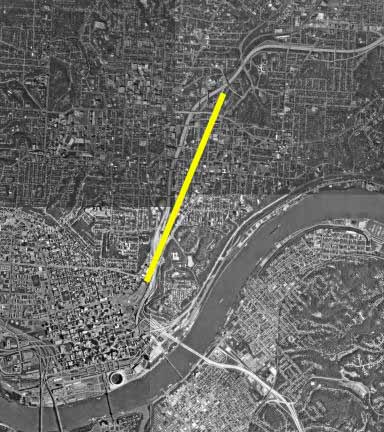
Route of the incomplete Deer Creek Tunnel, with I-71 clearlyvisible.
No sections of the "Northeast Expressway" openedbeforeits designation as I-71, but it was still interchangeably referred tobyits original name in newspaper reports for several years. NoNortheastExpressway signs were ever erected, unlike the MillcreekExpressway. The first section of I-71 to open was between I-270 in Columbus and apointa mile within Hamilton County near the Warren County line. Thisstretchwas dedicated in October 1964 before any construction began inCincinnatiwithin the nonexistent I-275 loop. The first stretch to opencloserto Cincinnati was from I-275 to Kenwood Rd. in December of1969. The Lytle Tunnel and the elevated mile north to Reading Rd. opened indowntownCincinnati in 1970. The gap between Eden Park Dr. downtown andDanaAve. was not filled until December of 1974. A 1973 landslide atthebase of Mt. Adams, another the following year, and subsequent designandconstruction of the nation's first post-tensioned retaining walldelayedopening of the I-471 connection until 1985.
I-71 through Downtown Cincinnati
I-71 forms the southern and eastern border ofCincinnati'scentral business district, interchanging directly or indirectly withroughlya dozen city streets, in the process separating downtown from theriverfrontto the south and from Mt. Adams to the east. From the BrentSpence Bridge, I-71 separates from I-75, turns east, and and descendsintothe Ft. Washington Way trench. This mile was originally completedin 1961 (The Brent Spence Bridge opened in 1963 and I-75 north of thebridgein 1964) but was completely rebuilt from 1998-2000. At thesoutheastcorner of downtown, I-71 curves north through the Lytle Tunnel. FortWashington Way and the LytleTunnel are discussed on this website at length in separate sections.
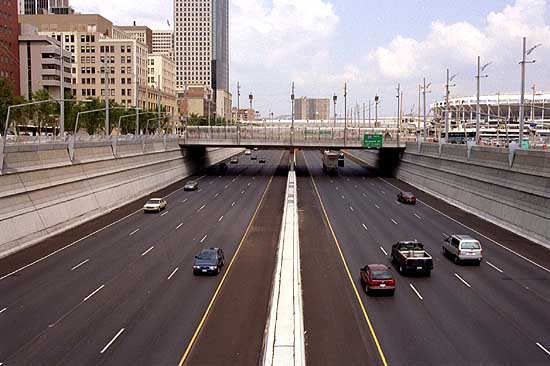
I-71 through the recently rebuilt Ft. Washington Waytrench.
[Jake Mecklenborg 2001]
North of the tunnel, I-71 travels for a mileelevatedabove the former CL&N railroad yard, separating downtown from thebaseof Mt. Adams. Although this section appears extremelycomplicated,no ramps in this area connect I-71 directly with downtown streets, withthe exception of 5th St. to I-71 north. This stretch reconfiguredGilbert Ave. and to a lesser extent Reading Rd. and Liberty St. intoexpresswayfeeders, and used the Lytle Tunnel's single-lane center tube as itsprimarydowntown exit. This center tube led to a single lane distributorthat ran in Ft. Washington Way's median with exits at Main St. and VineSt. The center tube now leads to a simple four-way intersectionwith3rd St. and Broadway.
I-71 at the Eden Park Drive/Dorchester Ave. interchange.
[Jake Mecklenborg November 2004]
Since the opening of this stretch of I-71 in 1970,I-471,its massive four-lane 6th St. exit, and reconstruction of the GilbertAve. Viaduct have changed the landscape. I-471's large fourlane6th St. exit ramp opened in 1985 and the 3rd St. Viaduct was rebuiltcontemporaneouslywith Ft. Washington Way 1998-2000. Additionally, the CL&Nrailroadceased operations, but segments of its tracks remain at certain points,and its bridge still stands just south of the Reading Rd. ramps. Its short tunnelsurvives in Walnut Hills as well, immediately parallel to the I-71northramp from McMillan St.
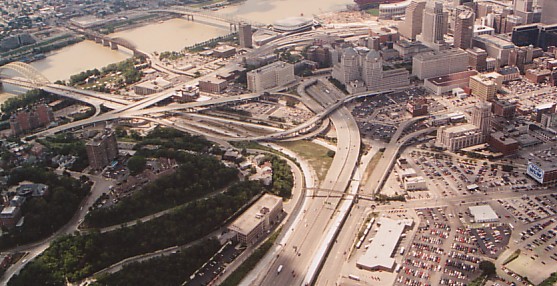
Overhead view of I-71 approaching the Lytle Tunnel
[LarryStulz photo]

A view of elevated I-71 downtown from the I-471 6th St. exit.
Girders in this area have since been repainted green.
[Jake Mecklenborg June 2001]
I-71 Walnut Hills / Evanston
This final I-71 link opened in 1974 and travelsdirectlythrough the residential neighborhoods of Walnut Hills andEvanston. It is the site of some of Cincinnati's more eccentric expresswayconstruction,including the area's longest non-feeder interchange ramp. Thissouthboundentry ramp from Montgomery Rd. parallels the the expressway for severalblocks, then swings out of view for a few hundred yards before mergingwith the expressway over a half mile from its point of origin. Allother interchanges along this stretch are irregular, prompting theCincinnatiPost to publish diagrams of them in preparation for their opening (thatarticle and its diagrams will be added to this site in the future).

I-71 viewed from the McMillan St. overpass.
[Jake Mecklenborg Summer2000]
This stretch was originally planned to include twoadditionalmajor interchanges, one at Martin Luther King Dr. and the other atVictoryParkway. The Martin Luther King interchange was dropped due tobudgetingand proximity to the McMillan Ave. ramps, but its construction is nowexpectedby 2010. Meanwhile, city council fought against area residentsforconstruction of the Victory Parkway interchange. According to a1970Cincinnati Enquirer article, the Victory Parkway interchange "woulddefacethe environment and interfere with the 'quality of life' in anarea...". Construction was blocked and Victory Parkway carries on today withoutaninterchange and is probably the better for it.
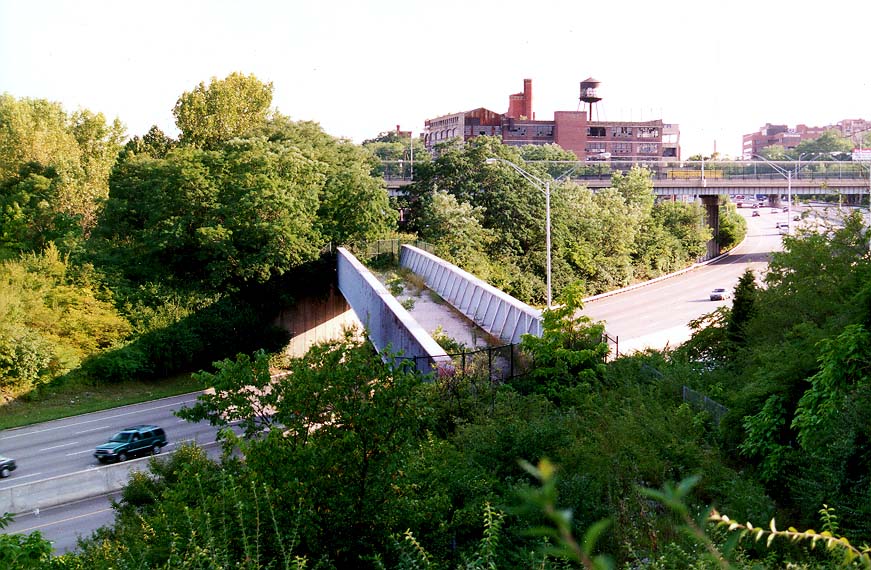
This overpass in Walnut Hills, part of the CL&N RR line, was abandoned in the 1980's
[Jake Mecklenborg Summer 2000]
Between Victory Parkway and Martin Luther King Dr.standsthe large Blair Ave. overpass, carrying four lanes on what is probablythe longest and highest I-71 local road overpass. My guess isthatit was at one time intended as the compromise site for an interchangeinthe area. There is no other explanation for its existence, as itconnects Reading Rd. and Montgomery Rd. via obscure side streets and nodoubt those who live nearby rarely use it as a shortcut. Whentaking photographson it for this website, I had all four lanes to myself for severalminuteswithout a single passing car. By all appearances it is among themost conspicuouswastes of expressway funding in the Cincinnati area and costs asubstantialamount of money to maintain.

Southbound at the Blair Ave. overpass in summer 2001.
Much of the stretch through Evanston obliteratedDuckCreek Road, but five sections of it still exist. Check out http://www.duckcreek.org/ for an extensive overview of what was and what still remains of DuckCreekRd. and the surrounding area.
I-71 Norwood through I-275 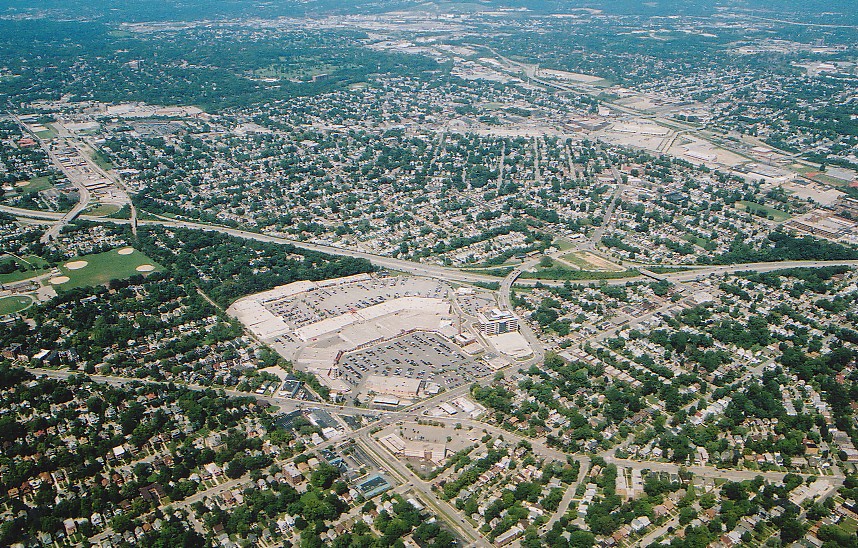
Summer 2004 view of I-71 just south of the Norwood Lateral.
I-71's eccentric ways continue through Norwood,whichis the site of one of the Cincinnati area's most convolutedinterchanges. Here the Norwood Lateral terminates simultaneously at Ridge Ave. andI-71. The lack of major roads in the immediate area resulted in interchangerampsthat in several cases originate or run onto residential sidestreets. The situation is complicated by a nearby railroad wye and the B&Omainline,which cross the expressway at several spots. Perhaps mostproblematicis the wye approach bridge over the ramp connecting the eastboundNorwoodLateral to southbound I-71, which blocks the view of the I-71 merge anddictated the ramp's sharp curve.
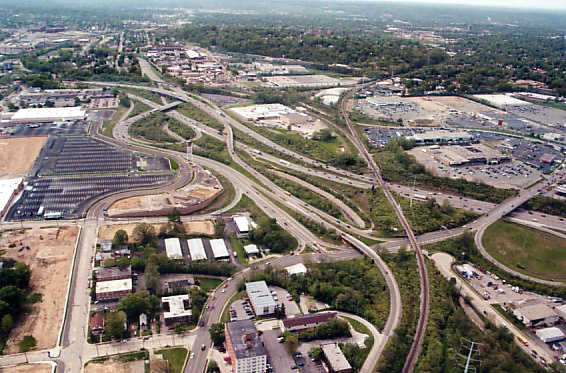
I-71 mile 7 at the Norwood Lateral interchange.
[LarryStulz photo]
I-71 travels due east from Norwood to thethree-levelRed Bank Rd. interchange, or "Red Bank Modified Expressway" as it wasofficiallylabeled during planning and by its present signage. The Red Bank"expressway" connects I-71 with Columbia Parkway but is simply a wideroadwith a high speed limit. It intersects most area roads at gradeandis lined by many businesses.
The Red Bank Rd. interchange.
[Larry Stulz photo]
The Red Bank Rd. interchange marks thespot where I-71 leaves the prewar density of Cincinnati and Norwood andenters postwar suburbs. I-71 is generally lined by woods andneatlykept residential areas north of this point.
I-71 at Kenwood Rd.
[Larry Stulz photo]
After Kenwood Rd., home to Kenwood Towne Center andotherlarge retailers, the next noteworthy point along I-71 is the CrossCountyHighway interchange. This interchange is the site of the twoat-gradeexpressway interchange ramps in the Cincinnati area. HeresouthboundI-71 southbound drivers must cross the westbound lanes of Cross CountyHighway in order to head east to Montgomery Rd. Immediately eastof the I-71 bridge is a 3-way interchange between the through lanes ofCross County Highway, a northbound exit ramp from I-71, and an entranceramp to I-71 north.
North of Cross County Highway I-71 is intermittentlylinedby high sound-proofing walls which were installed in the early1990's. Ivy has since begun to grow up the walls at various spots, and somearearesidents decorate their section of the wall for Christmas and 40thbirthdays.
I-71 north of I-275
The I-275 interchange sprawls over a large area andunlikethe nearby I-75/I-275 interchange natural foliage was retained in thespacesbetween ramps. The interchange is highly congested due recentdevelopmentin the area. Fields-Ertel Rd., the first interchange north ofI-275,is a disaster in suburban planning. Due to the inability of localofficials to limit building permits in the 1990's, the most aggravatingtraffic in the Cincinnati is not downtown, but 19 miles northeast of it.
The next interchange is King's Island AmusementPark,which opened in 1972. The park's rides have distracted passingdriverssince and have no doubt resulted in a few wrecks over the years. Significant suburban growth came to the area in the 1990's, but as ofyetit has not extended north of this interchange.
About 10 miles northeast of King's Island I-71crossesthe Little Miami River Gorge on the longest interstate bridge inOhio. A rest stop and scenic overlook is located at this point. Theoverlookwas never very scenic to begin with, and hillside trees have obscuredmostof the view so that it is not worth stopping to see today.

1993 photo by Philip Greenspun
North of this point I-71 heads directly for ColumbusOhio,with its longest single straight stretch measuring seven miles.
More photos: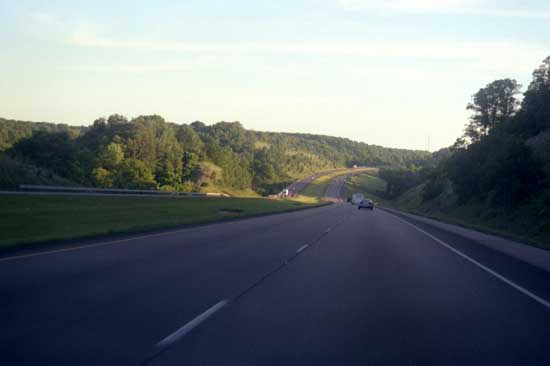
I-71 heading south in Kentucky towards Louisville. For info onI-71/75, see the I-75 section.
I-71 at the Eden Park Drive/Dorchester Ave./Florence Ave. interchange,
looking south toward downtown.
[Jake Mecklenborg November 2004]
Many interstate signs are in need of updating -- Riverfront Coliseum has
changed names three times since 1997 and the stadium to which this
sign refers was demolished in 2002.
[Jake Mecklenborg November 2004]
I-71 at Pfeiffer Rd.
[Larry Stulz photo]
I-71 at King's Island Amusement Park.
[Larry Stulz photo]
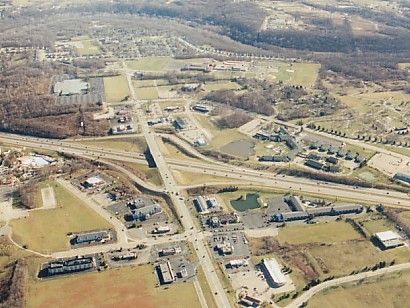
I-71 north of King's Island.
[Larry Stulz photo]